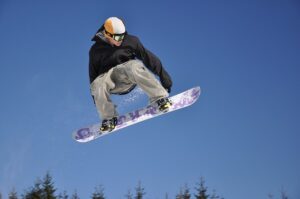Your Back and Snowboarding
Snowboarding is becoming more popular across all age groups. While riding down the slopes can be great exercise and fun, there is also a risk of injury from the sport. Learn more about your back and snowboarding.

Snowboarding vs Skiing Injuries
Whether it be on a board or skis, there is a risk of injury if you hit the slopes.
There are some injuries that both snowboarders and skiers are susceptible to. These include oversuse injuries (think staying in one posture for too long) and ground reaction forces (think the presure from impacting the ground as you ride over bumps).
Other injuries that are common for skiers may not be common for snowboarders, and vice versa. For example, skiers are prone to knee injuries. However, knee injuries aren’t as common in snowboarders. In contrast, ankle injuries are more common in snowboarders and less common among skiers.
Other common snowboarding injuries include head (ie: concussion) and wrist injuries.
The risk for head and spinal cord injuries is much higher for snowboarding than it is for skiing.
Snowboarding Spinal Cord Injuries
Jumping is a common cause for spinal cord injuries among snowboarders. This often occurs as a result of a burst fracture or an anterior compression fracture.
Burst Fracture
A burst fracture is when one or more of the vertebrae burst in pieces. This most commonly occurs as a result of a sudden significant pressure downward or upward on the spine. With snowboarding, this could be the result of a fall or incorrect landing from an ariel jump.
Learn about different types of spinal fractures.
Anterior Compression Fracture
A compression fracture is a specific type of break to one of the vertebrae in your spine. The main “body” portion of the vertebrae breaks during a compression fracture. The effect can be thought of like a collapse of that area of the spine, hence the term “compression” fracture. It’s as if the spine compresses in that area.
What is a Compression Fracture and How Are They Treated?
Anterior compression fractures, which can occur during snowboarding, is a compression fracture that occurs on the front (or anterior) portion of the vertebrae.
Overuse Injuries Common to Skiers and Snowboarders
If you read our article on skiing and back pain you’ll know that some spine injuries that take place on the slopes aren’t the result of a fall.
Maintaining one posture or repeating the same motion over a long period of time can result in strain or injury. The bending and twisting motion during snowboarding can lead to stress on the spinal discs and contribute to back overuse injuries.
The “bouncing”, vibration, or pressure downward onto an immovable surface (the ground) also stresses the components of the spine. When you land from a jump, all the energy your body had coming down from a jump is translated back upward when you hit the ground. Your spine absorbs a lot of that energy. This is another form of a spine overuse injury that can result from snowboarding.
Snowboarding Safety Tips
Snowboarding is a fun way to enjoy the winter months, be social, and get exercise. There are some things you can do to keep the experience enjoyable and injury free.
Wear appropriate personal protective equipment (ie: helmet) and choose slopes and tricks that are appropriate for your experience level. In addition, it’s good to ride with a friend who can get help in the event of a bad fall or emergency.
Whether you skate, sled, ski, or snowboard, Saratoga Spine hopes you get some exercise and enjoy the winter here in New York.
References:
